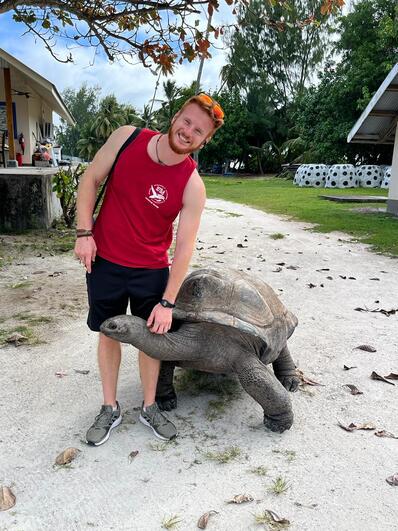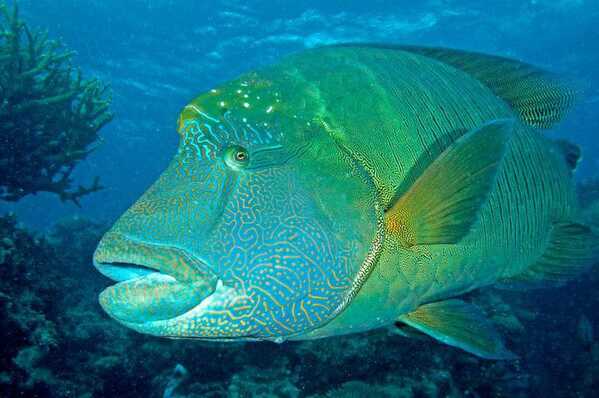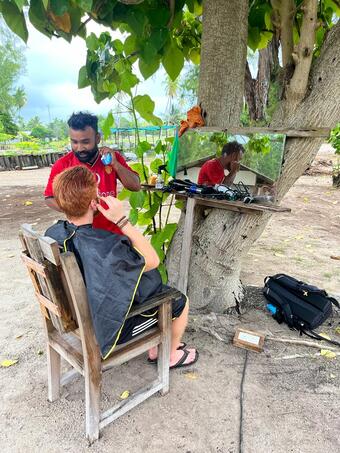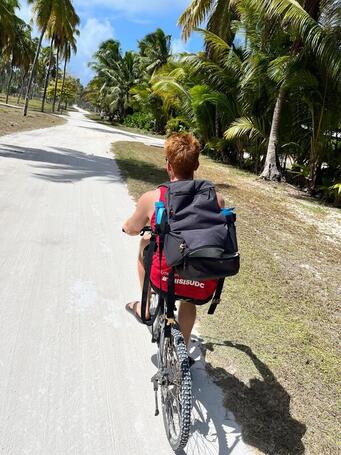|
Napoleon Wrasse (Cheilinus undulates) is one of those fish that once encountered you can never forget. This is mainly on account of the sheer size of this gentle giant which can reach 230 cm and can weigh as much as 190 kilograms. It is also a beautiful fish, with scales of a myriad of colours from green, mixed up with blue, and a tinge of yellow and purple close to its eyes resembling eyelashes. “Madanm Tonbe” or “Aya Zerar” in Creole is also called different names in different countries such as Maori Wrasse or the Humphead Wrasse. The latter is on account of the hump above its head which protrudes more as the fish matures and is said to look like the hat worn by the French revolutionary army led by Napoleon Bonaparte.
“The Napoleon Wrasse is a slow-growing fish which makes it naturally rare. However, it plays an important role in the ecosystem as they feed on predatory species such as thorns-of-crowns, and therefore allowing a healthier ecosystem to thrive,” states Gregory Berke, the Director of Conservation and Science at the Island Conservation Society (ICS). These attributes of size, shape and colour have made this species from the Wrasse family, also called Labridae, a fishermen’s prized catch in the Indo-Pacific region. The frenzy to catch the biggest wrasse in the world led to the conservation status of this species being upgraded in 2004 by the International Union for Conservation of Nature (IUCN) from vulnerable to endangered. Additionally, the Convention on International Trade in Endangered Species of Wild Fauna and Flora (CITES) also called for more strenuous regulations against trading of Napoleon Wrasse as displays in aquariums. Since then, several of the 50 countries from the East Coast of Africa to the Pacific where the Napoleon Wrasse could be found have introduced new regulations to protect this endangered species. Such global concern in the “King of the Reef” has yet to reach Seychelles were the species is not protected or subject to fishery regulations. This is in spite that the “Madanm Tonbe” or “Aya Zerar” is rarely seen or caught around the Inner Islands. “We would caution fishermen if they ever catch a Napoleon Wrasse to release it. It's a majestic fish that is worth the next photo on social media, but being an endangered species, this could also be the last photo of the fish,” states Berke.
0 Comments
 My stay on Desroches Island as a volunteer for ICS was a delight. I learned what the necessary conservation work on a remote island is like. The importance of an organisation that keeps track of different species and their breeding behavior is tremendous. After a learning phase I was able, to contribute my part in the weekly tasks of the team. I conducted turtle patrol to determine, if Green turtles had came to the beach during the night to lay their eggs. I also helped collecting data about the number of different sea birds and their behavior as well. I am grateful, that organisations like ICS invest time and energy in protecting endangered species, like the beautiful Wedge-tailed shearwater, whom a regularly visit to their nests at nightfall became one of my favorite activities. I also learned a lot about tortoises and their behavior since another one of my tasks was feeding and caring for the hatchlings and juveniles in the sanctuary. On these occasions, I could interact with the visiting guests. I have rarely seen creatures as lovely as these little fellows, which made the "work" a real joy. However, the sheer amount of tortoises in the juvenile pen made the food collection a challenging task; unfortunately tortoises do not like palm leaves! I even witnessed a tortoise laying eggs, which is a very rare sight. Sadly, for the safety of the hatchlings we had to move the nest, because she laid in the middle of the road. But my team was sure that the eggs would survive the move. I definitely got sensitized in regard of my behavior as a consumer of one way plastic packages and bottles, when we did the beach cleanup together with a group of other people from the island. That time, we collected a jaw-dropping 183 kilos of waste, which is a huge number, especially knowing that next month the beach will again be polluted. My report would not be complete, if I would not mention the few downsides the live on such a remote island brings with it. I learned what it means, to live with almost no internet and to be dependent on the materials available on the island. I like to think of this as part of the experience but it should not be underestimated. Besides that, I was very happy with the accommodation of course and the delicious meals I could enjoy every day. I also made some amazing friends and spend a wonderful time with them. I will definitely not forget my time on Desroches. Thank you everyone! Peter |
Categories
All
Archives
June 2024
|




